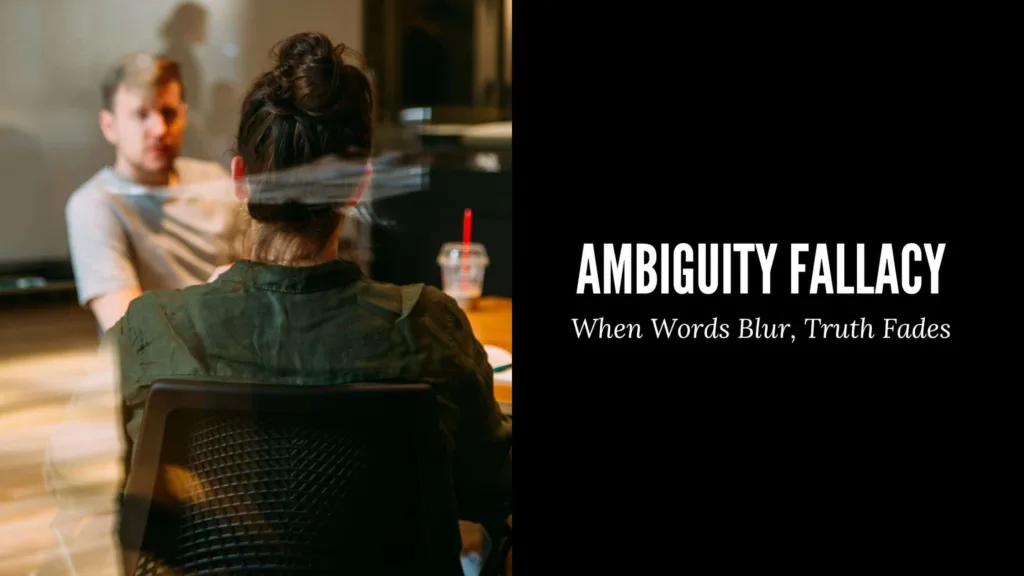In logic and arguing, it’s super important to be clear. But sometimes, words can be tricky, and they can confuse even really smart people. The ambiguity fallacy is one of those tricky things. It’s a sneaky mistake in thinking that takes advantage of this confusion to make arguments weaker. Let’s take a closer look at this mistake, what it looks like, and why it matters.
What is Ambiguity Fallacy?
Ambiguity Fallacy happens when someone uses words or phrases in an argument that can mean different things. Because of this, people can understand the argument in different ways. This lets the person making the argument control the discussion to their benefit. Instead of having a real discussion, they use this uncertainty to avoid talking about important points. They rely on the vagueness of what they say to make it seem like their argument makes sense, even if it doesn’t really.
For example, imagine someone saying, “We should spend more money on education.” That sounds good, right? But it’s vague. Are they talking about spending more money on teachers’ salaries, school supplies, or building new schools? Without more details, it’s hard to know what they really mean. And that’s where the ambiguity comes in.
Different forms of Ambiguity
- Word Ambiguity:
- This happens when a word can mean different things.
- For example, if someone says, “I saw a man with a telescope,” it’s not clear if the person holding the telescope saw the man or if the man had the telescope.
- Syntactical Ambiguity:
- This happens when the order of words in a sentence makes it hard to understand.
- For in the sentence, “I shot an elephant in my pajamas,” it’s not clear if “in my pajamas” means the shooter was wearing pajamas or if the elephant was.
- Semantic Ambiguity:
- This is when a word has different meanings.
- For example, “bank” could mean where you keep money or the edge of a river, depending on how it’s used.

These types of confusion can make it hard to understand each other. Word ambiguity is when a word has many meanings, syntactical ambiguity is when the sentence structure is confusing, and semantic ambiguity is when the meaning changes with the situation. Knowing about these helps us talk more clearly and avoid mix-ups.
Implications of Ambiguity Fallacy
- Legal Problems:
- Confusing words in contracts or laws can make people argue in court.
- People might not agree on what they really mean, causing problems and unfairness.
- Politics and Talking Publicly:
- Politicians and public figures might use unclear words on purpose.
- They do this to avoid being blamed, confuse others, or hide what they’re really doing.
- This can mess up how democracy works and make people not trust their leaders.
- Science and Learning:
- If research or ideas aren’t clear, it’s hard for others to believe in them.
- This can slow down how much we learn and stop us from talking about important things.
Related Article: Red Herring Fallacy: Distracting from the point
How to cope?
- Say Things Clearly: Use simple words so people understand you better.
- Ask Questions: If something doesn’t make sense, ask for more explanation.
- Check Facts: Look for proof before believing something.
- Think About It: Don’t just agree if something sounds confusing. Think if it makes sense.
- Keep Learning: Learn more so you can understand things better and not get tricked.
Conclusion:
The ambiguity mistake reminds us that language and how we think can sometimes be confusing. It’s like when someone says something that can mean different things, and it confuses everyone. But in a world where this happens a lot, it’s really important to try to be very clear and exact when we talk or write.
Understanding this mistake helps us protect ourselves from falling for it. It’s like learning how to spot when something doesn’t make sense. By doing this, we can have smarter and more honest conversations with each other. It’s like making sure we’re all on the same page and not getting tricked by confusing words or ideas.

Pingback: Suggestibility Psychology: The Subtle Art of Persuasion